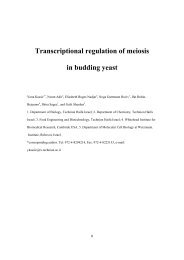Ab Initio Study of Silyloxonium Ions
Ab Initio Study of Silyloxonium Ions
Ab Initio Study of Silyloxonium Ions
Create successful ePaper yourself
Turn your PDF publications into a flip-book with our unique Google optimized e-Paper software.
<strong>Ab</strong> <strong>Initio</strong> <strong>Study</strong> <strong>of</strong> <strong>Silyloxonium</strong> <strong>Ions</strong> Organometallics, Vol. 16, No. 26, 1997 5943<br />
Chart 1<br />
siloxane. The major change upon protonation <strong>of</strong> silylation<br />
occurs at the peripheral hydrogens, which become<br />
less negatively charged. The total charge on each <strong>of</strong> the<br />
H3Si groups in disiloxane 4a becomes less negative by<br />
0.11e (NPA) as a result <strong>of</strong> protonation or silylation.<br />
Similar results are observed for the cyclic systems 5-7.<br />
The positive charge on the exocyclic Si atom in 5c-7c<br />
is considerably smaller than that on the Si 1 atoms<br />
within the ring (Table 3).<br />
NPA shows that in neutral siloxanes electron delocalization<br />
from bonding to antibonding orbitals (“non-<br />
Lewis structures”) contributes 0.6% (4a, 7a) to 0.85%<br />
(5a, 6a) <strong>of</strong> the total electron density. Thus, stabilization<br />
<strong>of</strong> the molecular structure associated with delocalization<br />
effects is somewhat larger in oligosiloxanes, such as 5a<br />
and 6a, than in compounds having only one isolated<br />
SiOSi linkage (4a and 7a), since the energy <strong>of</strong> the<br />
n(O′)fσ*(Si-O) interaction is larger than that <strong>of</strong> the<br />
σ(Si-H)fσ*(Si-O) interaction. The contribution from<br />
these delocalization interactions is slightly reduced upon<br />
protonation and silylation (ca. 0.4% <strong>of</strong> the total electron<br />
density in 4b and 7b and 0.8% in 5b and 6b). This is<br />
also reflected in the calculated delocalization energies<br />
(obtained by zeroing all orbital interactions and recalculating<br />
the energy <strong>of</strong> the altered Fock matrix 12 )<strong>of</strong><br />
siloxanes and <strong>of</strong> the corresponding oxonium ions. For<br />
example, the total delocalization energies for 4a-c are<br />
146, 108, and 174 kcal/mol (73, 54, and 58 kcal per Si-O<br />
bond), respectively. The delocalization pattern <strong>of</strong> the<br />
other siloxanes is more complicated, making detailed<br />
analysis difficult. However, protonation or silylation<br />
always reduces the total delocalization stabilization<br />
energy <strong>of</strong> the siloxane. We find, as noted previously, 16a<br />
that the d orbitals on Si do not participate significantly<br />
in electron delocalization; the d(Si) orbitals being populated<br />
by only 0.05-0.06 electron (NBO).<br />
The strongest delocalizations (according to NBO<br />
analysis) in neutral siloxanes XH2SiOSiH2X (X)H, O,<br />
C) are those involving donation <strong>of</strong> electrons from the<br />
oxygen lone pairs to the antibonding σ*(Si-H) and σ*-<br />
(Si-X) orbitals. In the silyloxonium ions the direction<br />
<strong>of</strong> electron transfer is reversed. The strongest interactions<br />
in this case are those in which the �-n(O) (in 5b,c<br />
and 6b,c) σ(Si-H), and σ(Si-X) orbitals donate electrons<br />
into the σ*(Si-O) antibonding orbitals <strong>of</strong> the<br />
oxonium center. The other interactions, not involving<br />
the oxonium center, are considerably weaker. The<br />
dominant delocalization interactions in cyclosiloxanes<br />
5a and 6a as well as in their protonated forms, 5b and<br />
6b, together with the corresponding second-order stabilization<br />
energies (kcal/mol), are shown in Figure 2.<br />
The unsymmetrical second-order energies <strong>of</strong> the<br />
n(O)fσ*(Si-O) interactions illustrate polarization <strong>of</strong><br />
the molecule induced by the positive charge (Figure 2).<br />
Figure 2. The strongest delocalization interactions occuring<br />
in the cyclosiloxanes 5a, 5b, 6a and 6b, according<br />
to the NBO second-order perturbative analysis (for clarity<br />
only representative interactions <strong>of</strong> a series <strong>of</strong> symmetrical<br />
interactions are drawn). The numbers on the arrows are<br />
the energies associated with the interactions (kcal/mol).<br />
The elongation and weakening <strong>of</strong> the Si-O bonds at<br />
the silyloxonium center can be attributed to two cooperative<br />
effects. The first is the electrostatic repulsion<br />
between the SiH2X moieties (SiH3 in 4b and 4c) around<br />
the oxonium center. In a nucleophilic substitution step<br />
(e.g., in the propagation step <strong>of</strong> polymerization), this<br />
effect is amplified by attractive interactions between the<br />
SiH2X groups and the electron-rich nucleophile. The<br />
second effect is the hyperconjugation involving electron<br />
transfer into the Si-O antibonding orbitals at the<br />
oxonium center, as is illustrated in terms <strong>of</strong> resonance<br />
structures in Scheme 2.<br />
The contribution <strong>of</strong> “no bond” resonance structures<br />
<strong>of</strong> type 11b to silyloxonium species is reflected by<br />
changes in the geometry <strong>of</strong> the SiH2X groups. Thus,<br />
the Si-H bonds shorten by ca 0.02 Å upon addition <strong>of</strong><br />
H + or SiH3 + , reaching values similar to those in SiH3 +<br />
(1.454 Å), and the H-Si-H angle adopts intermediate<br />
values (115.6° in 4b, 114.4° in 4c) between those in<br />
neutral 4a (109.0°) and in SiH3 + (120°). In cyclosiloxanes<br />
5c and 6c the Si-O bonds geminal to the oxonium<br />
center (Si 1 -O 2 ) are also considerably shorter than in<br />
neutral siloxanes (Figure 1). These geometric features<br />
suggest that the silyl groups bonded to the oxonium<br />
center have partial silylenium cation (SiH3 + or SiH2X + )













